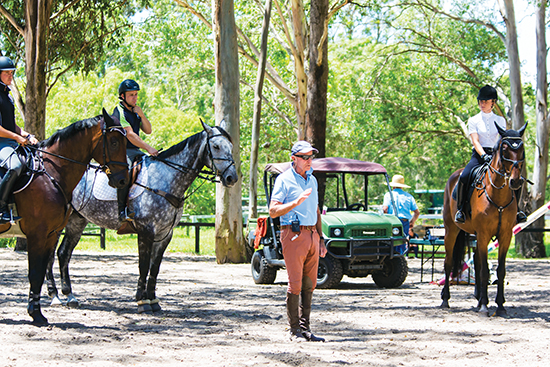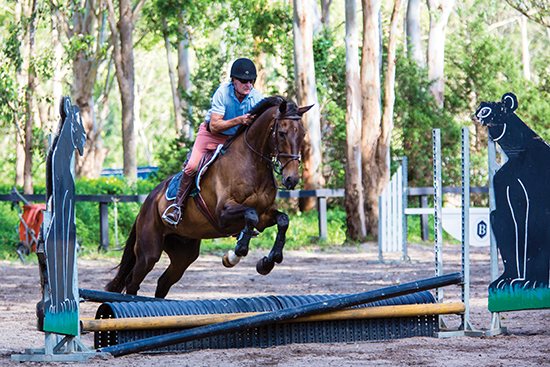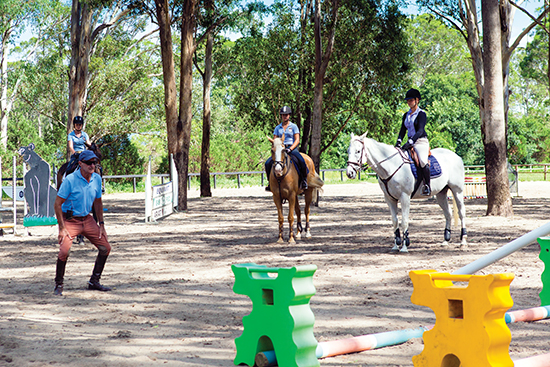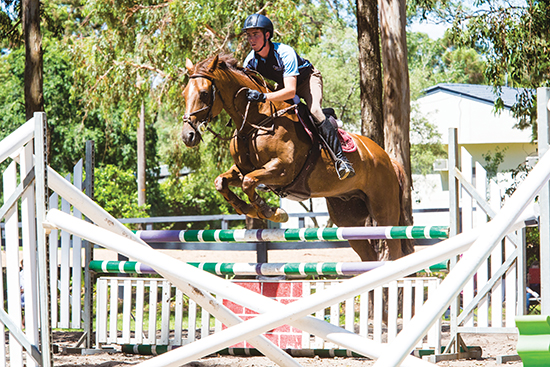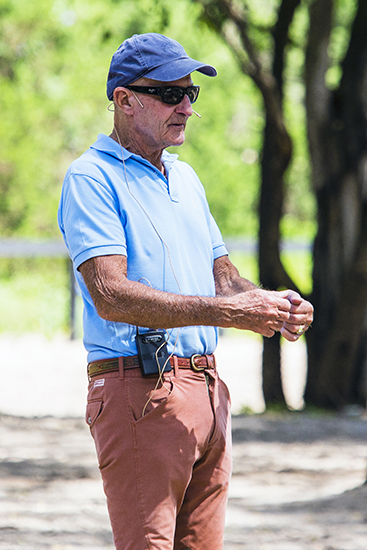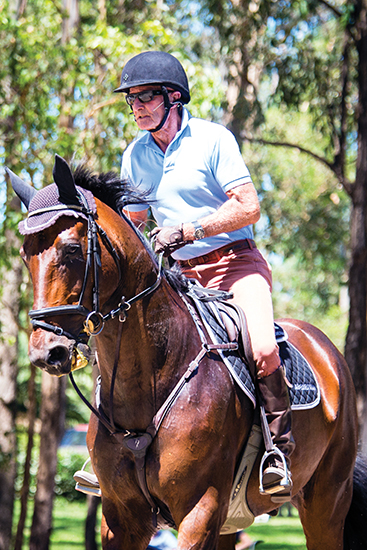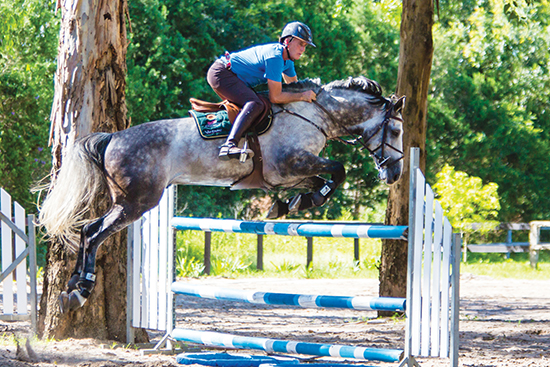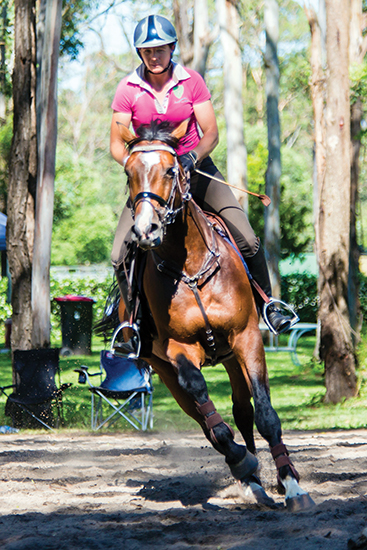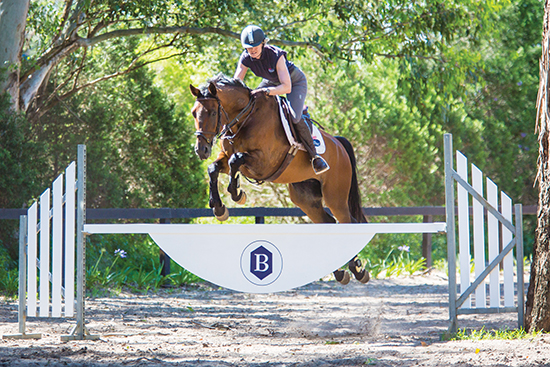Story and photos by Rebecca Ashton
One of the best ways to be a good coach is to watch the great coaches at work. I had the marvelous fortune to do such a thing at Helen Chugg’s Diamond B Farm, just west of Sydney where legendary American showjumping instructor George Morris was conducting a clinic for coaches.
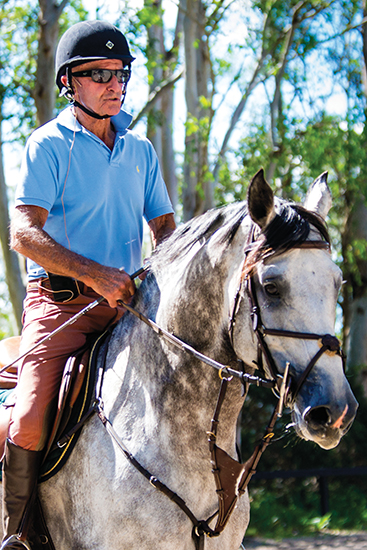
George on Chris Chugg’s Cera Cassiago
There’s a reason George Morris has won his place in the firmament of great trainers. It’s not his dry, memorable, facebookable one liners, though it’s worth watching one of his clinics just for them. He has a system. A simple, tried and true, reliable system with an emphasis on rider position and use of the aids. It’s been developed not just from sitting in the corner of the arena, but from decades of experience on the back of the horse. Having said that though, George is a great watcher, a tremendous studier, a studious reader and remains, to this day, a scholar of the sport he loves. He is a generous trainer and loves sharing his knowledge with those who work hard and are truly interested.
The day was set out with four sessions of three to four riders each, beginning with lower level riders and working up to some of our top stars, the gum tree studded arena in which it was staged making the baking heat bearable. No matter what level the horses and riders, the sessions had the signature George Morris system behind them. And you don’t want to be late to a lesson. On time means 10 minutes early. “I grew up in New York City. New York City is hustle!” explained George.
Each lesson began the same way; gear and position check. The trainer was amassing a lot of information about how a combination went even before they moved, “I see that bit and I see contact problems,” George indicated to one rider. And to us coaches, “Get people in a habit of looking straight ahead. Start with looking up and ahead at a point, then lean forward slightly so that they’re in a squat. Step two, rise to take the seat out of the saddle, then displace weight into heels and sink back into the saddle. This is called weight displacement, the weight goes out of the seat and into the heels. The dressage school of sit, sit, sit, isn’t always correct. This is a jumping clinic not a competition dressage clinic.”
When George was happy with how the riders were turned out, it was time for work. First was the all important flat work so it was necessary for stirrups to be at flat work length and returned to that hole at the end of the lesson.
Morris is well aware that dressage and flat work can be easily bypassed by showjumpers and their instructors for the more exciting aspects of the discipline, but he had a warning and a reminder of the responsibility we have as trainers, “You can’t be a one horse/ one rider horseman. You must have a system built on scientific, modern thinking. The basis is dressage even though with the training for showjumping there are some differences. You have to have this basis for the horse’s physical and mental wellbeing. Anybody can be the one great rider with a couple of great horses. Anybody can do it. But as instructors you have decades of horses and riders to help. There has to be the mentality and interest to do this type of work before you jump.”
George explained how fast each pace should be and how to achieve it. “The horse walks about 6km/hr. Make the horse go with your leg and crop, not your seat.” Then he required a rising trot at about 10km/hr, canter at 14km/hr and finally a two point seat and slow gallop at 16km/hr. He wanted the horses to have a good, forward tendency and work on their own. This was explained to Rangimarie Whatley in no uncertain terms, “Rangi, canter your horse. You baby the hell out of her, I can tell. Canter.” George also isn’t a believer in treats for horses, “They start nipping and it’s no good for their mouth when you’re riding. There are enough mouth problems here in Australia.”
With rider position under control and the horses moving correctly at all gaits, George began to add some exercises, gradually and with good explanation; he is a communication king. The first was an exercise for turning and the American introduced it and broke it right down in an a manner that would not be easily forgotten. “What’s the difference between looking and seeing? Looking is focused at a point; seeing is using peripheral vision. That’s important. Riding a horse is very much like driving a car. I’ll drive with Paul Schockemöhle even though he goes fast as hell. There are some people here I wouldn’t drive with.”
“First collect your horse with slow sitting trot, then look where you’re going to go and then you turn. This is the order. Do it in stages. Even if it’s very fast, it needs to be a habit. You have to concentrate because most people do it wrong.”
The importance of good concentration kept coming up time and time again, “When people get on a horse, they go brain dead, no matter how intelligent they are. Discipline is important, concentration is important because riding is a dangerous sport. Don’t have a conversation with your student, educate them. We are teaching them to be horse trainers, though we don’t tell them that. Horse training. That’s what all this is.”
Exercises were only executed a few times, with no drilling of the horse and he encouraged other coaches to do the same, “If you had a group, you could do this exercise four to five times but there’s another lesson next week, so you don’t have to do it to death. I watch Isabell Werth. She is a horse trainer. She plays with the horse. She doesn’t grill them and grill them and grill them. She works them, she pats them, she gives them a loose rein. Don’t go 45 minutes doing the same thing. Mix it up. An exercise need only be three to ten minutes.”
Stirrups up and girths were rechecked before it was time to jump. Well aware of the horse’s welfare, George explained, “Most people in today’s sport want to jump. We can teach jumping without actually jumping. Poles on the ground, cavaletti and cross poles can teach jumping without breaking the horses.”
Before anyone took a fence, George explained his system further and the checklist he uses to progress horse and rider. “There are four basics of jumping that I teach:
1. You’re able to stay with the motion of the horse. (upper body)
2. You’re able to take a cavaletti and you have leg position with your heel down (lower leg)
3. You’re able to ride a line of sight and stop your horse at a certain point (eyes; direction and distance).
Release.
“With all these groups, I have to address all these cornerstones. Thomas Fuchs, Eric Lamaze, you’ll see this system in all these riders. It is a system of success. It works for not just some riders but lots of riders. Beezie Madden, she’s a great teacher because she teaches as she rides. And she can do that at all levels. This system accommodates all riders.”
Steps one to three were all addressed over the cavaletti while step four, the release, was practiced over a small cross rail then five strides to an oxer. “As you go over the jump, reach up and grab that mane.”
George on Rangi’s horse
Rangi was having a few issues with her mount and George was quick to jump onboard. “People, basically I hate teaching. No I like it but I sort of hate it. I like riding!” and was that half a smile I could see? Not one to miss an opportunity to have a ride, George rode a horse each session, but along with most things Morris undertakes, there was also a purpose. He could show the riders and spectators exactly what he was looking for. “Jim (Scobie), this is what you do, it’s popular today, you drop back in the saddle. You sit, it rushes the horse and makes him hollow. Don’t sit back on the horse like that in between the jumps. Stay with the horse. Watch me. I don’t have to do it by the seat of my pants like you do it.”
“This is half halt. When you execute it, you don’t have to sit down. You do have to keep the horse in front of your leg though. He has to be up in front and light. This obsession with seat, seat, seat. No. Light. Use different seats, people, not a single rigid or static one.”
“I’ll take this horse. I’ll keep this one. I don’t care if he’s 21. He can be in my birthday stocking next month. This is a horse that’s content. He is submissive, light, forward and in rhythm.”
“Good. Take a short break. These people were excellent. Leave me in peace for a minute on MY horse!” joked the master.
Session two saw some talented young riders and began the same way; gear check and position check. It then continued in the same fashion as the first group: flat work, stirrups up, cavaletti, cross rail to oxer and then and mini course. However, this time the work was a touch harder. It was assumed the basics were understood and George started to refine a little more, like a sculptor.
Hands were still a problem for these riders and George really wanted them to understand the importance of getting it right. “If the horse raises it’s head, raise your hand. Horses hate you pulling down and having a broken line below the straight line. It puts too much pressure on the sensitive bars of the mouth. You people can’t wait to pull the horse’s head down! How often do you see me pull the head down? You have to wait for the horse. It’s punishment/ reward. If the horse raises his head or shakes, I raise my hand and when he softens and takes the bit, I lower my hand back down.”
“You can break the line above the straight line but not below the straight line. Don’t see saw the horse’s mouth. You can close your fingers and resist, but don’t see saw.”
You soon realise that the horse always comes first in the Morris system. Not only does he dislike the modern style of over flexing the horses, but the back should always be considered. “To walk from trot, sink into the saddle. When did people stop thinking about the fragility of the horse’s back? The horse’s back is fragile, don’t be heavy.”
This group saw the introduction of lateral work and George again broke the process right down, “How do we control a horse’s shoulder? We have to control his feet. We use our hands via the opening rein or the neck rein but keep your hands up over the horse’s wither. To take the shoulders left, open the left hand and push the right hand into the shoulder. This is rocking the shoulder. Get the horse responsive. If you want to affect the horse’s shoulder, use the leg on the girth and both hands. If you want to affect the horse’s haunches, use the leg further back.”
This then lead on to turn on the forehand and leg yield, which George considers just the first step of haunches in rather than a movement in its own right.
Then it was cavaletti before the cross rail and oxer. These young riders were quite confirmed in the four step system of posture and instead of just looking at release, they had to practice short and long releases, but there were still corrections to be made. “Most of you have a habit, you jump a jump and then you grab them, not just with your hands but with your seat as well. It interferes with the horse’s gallop. Stay out of the saddle. I adjust my position all the time. It’s a habit. I’m old but I have posture.”
Will Mathews demonstrates the release on Master Footloose
This was a great segue to practice the two and three point seat. “When you’re jumping a course you use both. Up and down. It’s not always one or the other. What’s important is the upper body.”
Then it was time to try it out. “Two point around here and then just sink and slightly touch the saddle into three point contact, jump then back to two point after the jump. The upper body doesn’t change and the hip angle barely changes at all.” Being competent at using these two positions will improve the rider’s timing.
There was more evidence that George is always watching and learning and expects his students to do the same, “Keep it simple. There are two positions, both have the upper body forward to release the horse’s back. Kevin Staut, Patrice Delaveau are the ones to watch for the two point seat. They don’t change the angle of the hip. Laura Kraut and Ian Miller are good ones to see that too.”
George only gets the riders to focus on one thing at a time and now the group’s attention was on heels. Each rider popped over a jump focusing on nothing but their heels and lower leg position. “I don’t care what the horse does or what happens as long as their heels are down after they’ve jumped that liverpool. To get heels, we do a two point seat and then it has to be maintained in the three point. No matter what happens, the heels must be down.”
Eyes were next. Where the first group was riding to a point, this group now had to practice over three jumps. “Turn left into a jump, straight for three strides, jump, six strides and turn right, jump, turn left. I don’t care if they make a mistake, I just want them to concentrate on their eyes.”
The progression to look for distances was discussed. “Distance is a choice. I want you to jump over the liverpool. Let go of your horse a little bit just before the turn. Watch the top rail and sense the distance. If I’m not sure I wait, I stay still. That’s the recipe to see a distance. Look at it, let go, measure (so you know whether to move up or wait). If in doubt, wait it out.”
After lunch, the third group of riders saw more finessing of the system and after the gear and position check, the main focus was on straightness, achieved by having good control of the horse’s lateral positioning. The master sited the greats before him, “Steinbrecht says, ‘Make your horse straight and ride him forward.’ Everyone should read Steinbrecht.
I suggest you get Gustav Steinbrecht Gymnasium of the Horse. Ride the horse from the back to the front. Always have him in front of your leg.”
“Your object in straightening is to put the forehand in front of the hind quarter. When the horse travels, his instinct is to go crooked with the shoulder out and haunches in because he is wider at the quarters than the shoulder. You have to put the hind quarter on the track with your inside leg. If the horse is crooked, he does not have to shorten his pace and you cannot collect.” Straightness was achieved using four track shoulder fore to three track shoulder in, making sure there was no change in the rhythm. Control of the forward part of the equation was practiced via transitions within the trot for a specified number of strides before shoulder fore and shoulder in were executed at the canter, leading to increased collection.
George then jumped on Rhys Stones’ BS On Air to give a demonstration and to recapitulate what he had been telling the group. “As you turn, keep the neck straight with the outside rein. Mobilise the shoulders. I touch him with the spur because he’s quite dead to the leg. You want them leg ridden; leg to hand. To start he needs to be active and in front of leg. Then straight with the forehand in front of quarters and inside hind on the track. For this I use shoulder fore. I want him active and regular. He must accept contact with his mouth. We have to get the horses on their hindlegs.”
George riding Rhys Stones’ BS On Air
George worked the horse in turns, shoulder fore, a few poles and canter to get him up and soft in front and active behind before a stretch, “Let the horse stretch but not rush. That’s good for his back.” Happy with how the horse was carrying himself, it was time to try some flying changes.
Morris explained the progression, “At first people, teach your horse in full seat in all exercises. He has to learn acceptance. If the horse bucks, he goes backwards into the aids. Sit, get his head up and push. Then sit up out of the saddle and now the horse is ridden just off the leg. Most people pull the inside rein. You have to do it with your legs. The problem in this country is that you accept mistakes, you accept less than perfection. Perfect practice is important.”
Stirrups up and it was time to pop over the cross rail and oxer. Again there was the warning of sitting in the saddle between jumps. “Don’t sit back after the fence. It’s arse wrapping. Stay out of the saddle. You’re indoctrinated with heavy seats, heavy horses. Keep it light! The horse has to carry you. You carry the horses here.”
The focus was then on the different ways of riding the horse to the jumps. “There are three ways to ride; in front of, with or behind the motion of the horse. Which are the two correct ones? With and behind. Which is smoother? With is smoother. Behind is stronger. Teachers, watch the riders’ hip angles. They are closed over the vertical and more open over the liverpool. That’s where you carry the horse which is sometimes very necessary. But your object is not to have to do this all the time. You have to have this tool, even though I don’t like it very much.”
The whole time George was looking for good self carriage in the horses and the riders doing as little as possible. “That should be the holy grail in all riding: self carriage. The horse should carry us, but that is not easy to teach people or to achieve. Get on the internet and watch John Whitaker. Watch Nick Skelton. Does he get horses operating in self carriage? Oh!”
This carried through to the next exercise getting the horses light and mobile with a single rail, triple and lots of bends and turns in between. Never for a second was rider position ignored. Heels down to control the leg and therefore not irritate the horse, staying out of the saddle, being aware of distances and knowing whether to ride to a fence or wait.
The final session saw some of our best jumpers take to the arena; Chris Chugg on Cera Cassiago, Vicki Roycroft on Congo and Amanda Madigan aboard Baluga. Even they weren’t immune to the obligatory gear check.
Chris Chugg and Cera Cassiago
George continued to break down ideas so everyone could understand, “We are interested in having the horse round. That’s bascule. It doesn’t happen from your hands or draw reins. It starts from your lower leg, principally your inside leg. This is what happens; a horse is in the pasture naturally hollow. You put a rider on its back and it’s worse. There are seven joints in the hind leg that have to flex, the most important, the hip and stifle. This engages the hind end. You get that with leg aids. Every exercise you want the hind leg under. When you engage the hind leg, the croup starts to drop and the ribs come out, the back comes up and the withers come up and as a consequence, the neck comes round. You lot are all obsessed with necks! The first question should be, is the horse active behind? Only then can he start to engage and get those seven joints flexing and bending.”
“That’s first. Impulsion. Not rhythm. How can you talk about rhythm if you don’t have impulsion?”
The riders first had to get their horses active with cadence, then straight, even on bent lines so small circles were included in the initial flat work. Next were lots of transitions and lateral work, including haunches in and counter shoulder in, stepping it up a bit from the previous group, before rising trot and resting the horse’s back, but keeping enough contact so the horse didn’t get quick. George warned against the canter to trot transition though, “I hate that transition because when you go and shorten the gallop, they come back to trot and we don’t want that.”
Amanda Madigan and Baluga
Always with the final job in mind, that is to jump a course, spiraling circles were practiced, “First circle is a maximum of eight metres. Ride three to four circles then go straight and repeat somewhere else. The base of the horse’s neck has to be quite straight and stiff so the bend is in the body. Tight spirals are perfect for the jumping horse.”
Everyone showed their flying changes before George jumped aboard Chuggy’s lovely import, with a running explanation on what he was doing, “What I want with this horse is that it engages and that is expressed with active paces; that the horse takes the bit, not by pulling his head down, but by you pushing him to meet the bit. First he has to be pushed against it from your leg and then away from the bit. I have to offer some resistance with my hand here so he pushes away from it. Equal pressure both sides of the horse’s mouth. I don’t carry my horse with my seat. No. I have legs and hands. As I push the horse, I have to keep him up in his forehand. You people think that it’s wrong to elevate the poll because the horrible fashion of riding today is rollkur. It is horrible for the horse and horrible for its muscles. Horrible. The fashion today is over-flexed, rubber necked horses. No matter how deep I sit, I’m not crushing the horse’s loins as I’m staying slightly in front of the vertical. The horse has to be light and responsive to the leg and I still keep him on the outside rein. Now I go into the second seat. His back comes up and he stretches.”
Chris got his horse back and George wanted everyone to fully understand what his ride was about, “So, you watched, my question is what did you see? Impulsion! Can you see what they’re doing to horses today? They’re breaking horses’ necks and ruining all the top line.”
Vicki Roycroft on Congo
Stirrups up and on to the oxer and cross rail, but now the riders had to ride deeper into the jump to get good bascule. The demand for self carriage was priority, “Good riders do it for the horse. Great horseman get the horse to do it for them. That’s why people like John Whitaker and Beezie Madden are at a different level. That’s why Beezie’s horse did well (at WEG) with other people. Self carriage is so important,” as was the request for a higher hand, “Old habits die hard….You people have been so indoctrinated to low hand and sitting in the saddle. The French don’t do that. Look at Kevin Staut.”
It was then onto a course, testing bends, super tight turns, distances and speed, with a big, fast gallop to a final panel.
At the end of each session, George was always so complementary of the riders and took time to include the auditors in the discussion, offering to have the riders demonstrate anything the spectators wanted them to. After thanking Helen Chugg for hosting the clinic, he concluded the day with the following, “This should be very clear, people. First to third grade, then fourth then college. You see here a system to assist you, it doesn’t change. You add more complex exercises but it’s all classical riding. This includes Caprilli. I will always protect the forward seat because it’s kinder for the horse, but you have to be able to sit in the saddle to get an uphill balance and the horse has to be under behind and up in the wither or else you can’t ride a forward seat. Nobody is perfect, but that’s our goal. Best to you all.”



